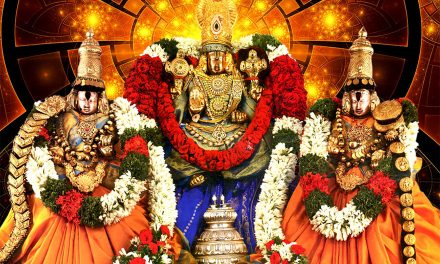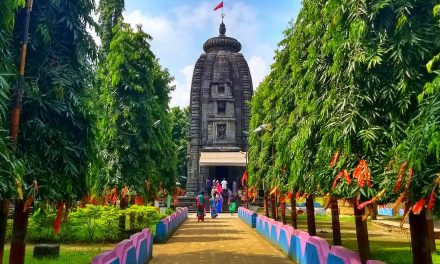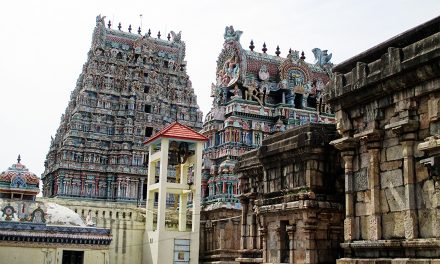The three most well-known Narasimha shrines in Andhra Pradesh are Ahobilam, Simhachalam and Mangalagiri. Mangalagiri means The Auspicious Hill. This place is one of the 8 important Mahakshetrams (sacred places) in India. The eight places where Lord Vishnu manifested himself are (1) Sri Rangam (2) Srimushnam (3) Naimisam (4) Pushkaram (5) Salagamadri (6) Thothadri (7) Narayanasramam (8) Venkatadri.
Thotadri is the present Mangalagiri. Lakshmi Devi has done tapas on this hill, and that’s why it was named “The Auspicious Hill”. There are three Narasimha Swamy temples in Mangalagiri. One is Panakala Narasimha Swamy on the hill, another is Lakshmi Narasimha Swamy at the foot of the temple, and the third is Gandala Narasimha Swamy at the top of the hill.
From all the directions, the shape of the hill looks like an elephant. The mountain is said to have come into existence when Pariyatra, an ancient king, had a son name Hrasva Srungi who visited all the holy and sacred places to regain normal bodily stature. He finally visited the holy place of Mangalagiri and stayed for three years, performing penance. All the devathas advised him to stay at Mangalagiri and continue to do penance in praise of Lord Vishnu. The father of Hrasva Srungi came with his retinue to take his son back to his kingdom, but Hrasva Srungi took the shape of an elephant to remain and become the abode of Lord Vishnu, who is locally known as Panakala Lakshmi Narasimhaswamy.
The temple of Sri Panakala Lakshmi Narasimhaswamy is situated on the Auspicious Hill. On the right side of the steps provided to reach the temple there is a stone inscription by Sri Krishnadeva Raya of Vijayanagar. A little further up, there are the worshipable Footprints of Sri Chaitanya Mahaprabhu. Midway on the steps there is a temple of Lord Panakala Lakshmi Narasimhaswamy (Pana-nrsimha, pictured above) with His mouth widely opened.
A dhwajasthambham was erected in front of the temple in 1955. Behind the temple there is the temple of Sri Lakshmi, to the west of which is a tunnel believed to lead to Vundavalli caves on the banks of the Krishna. The stone inscription of the kings of Vijayanagar also relate to the conquest of Rayalu over Kondapalli, and Siddhiraju Thimmarajayya Devara’s granting of a total of 200 kunchams (10 kunchams make one acre) land in 28 villages, of which Mangalagiri was one, and a gift of 40 kunchams by China Thirumalayya to Ramanujakutam.
The steps to the temple were constructed by Sri Channapragada Balaramadasu in 1890. There was a cave next to the Devi temple on the hill. It is said that there is a way to Vundavalli from that cave, and the sages used to go that way to take bath in Krishna River. Now the cave is very dark, and the way cannot be seen.
The Demon Namuchi
Lord Nrsimhadeva has established Himself on the hill in His man-lion form, assumed to kill the demon Hiranyakasipu, who was the rakshasa father of the great devotee, Prahlada. The Lord is also called Sudarsana Narasimhaswamy. After great penance, the rakshasa Namuchi obtained a boon from Lord Brahma that he would not be killed by anything wet or dry. He then began to harass Indra and the devathas. Encouraged and supported by Lord Vishnu, Indra commenced destroying the army of rakshasa Namuchi, who died in a cave in Sukshmakaram(small size), giving up his sthulakaram (physical manifestation). Indra dipped Sudarsanam, the disc of Lord Vishnu, into the foam of the ocean and sent it into the cave. Lord Vishnu manifested Himself at the centre of the disc, destroyed the Pranavayuvu (life breath) of the rakshasa with the fire of His exhalation. He thus got the name of Sudarsana Narasimha.
The blood that flowed from the body of the rakshasa seemed to have formed into a pool at the foot of the hill. The devathas themselves were unable to withstand the fire of the anger of the Lord and they prayed for appeasement. The Lord took amritam (nectar) and cooled down. This was in Krithayugam. The Lord said that he would be satisfied with ghee in Threthayugam, with milk in Dwaparayugam and with panakam (jaggery water) in Kaliyugam. Hence, in Kaliyugam the Lord is known as Panakala Lakshmi Narasimhaswamy.
In Threthayugam, the second of the four yugas, people who enjoyed in heaven as a result of their good deeds in the world are most unhappy to return to this world (when once the fruits of good deeds are exhausted, and the soul has to come back to the world). Some prayed to Lord Indra, the Lord of heaven, to save them from the impending fate. Indra advised them to spend their time in the world at Mangalagiri to attain heaven again.
In Krithayugam, the first of the four yugas when the sinners were few, Yamadharmaraja, the Lord of hell, advised them to wash off their sins by doing penance at Mangalagiri. Mangalagiri has been in existence since the beginning of the Universe, known by the names Anjanadri in Krithayugam, Thotadri in Threthayugam, Mangaladri and Mukthyadri in Dwaparayugam, and Mangalagiri in Kaliyugam. In all ages, Mangalagiri affords salvation to sinners.
In Krithayugam, Vaikhanasa Maharshi worshipped Lord Nrsimhadev, and the Deity is worshipped there even today in the temple. It is also said that Lord Rama, while departing for Vaikuntam after completing his mission in that incarnation, advised Anjaneya to stay at Mangalagiri, after obtaining his blessings to remain in this world for ever. Anjaneya took his adobe at Mangalagiri as Kshetrapalaka.
Panakala Narasimha Swamy – God Who Drinks Panakam
It is said that here in Mangalagiri, God is self-existent. In the temple, there will be no Deity of the Lord, but only mouth, widely opened to 15 cms. The mouth is covered by the metal face of Sri Panka-Nrimsha. The temple is to be opened till afternoon only, so that the devatas will perform pujas in the night. Pana-nrsimha takes jaggery water as an offering, poured with a conch. When the sweet water is poured into the mouth of the Lord, a gurgling sound is clearly audible as if the Lord is actually drinking it and the sound becomes shriller and shriller as and when the Lord is drinking. The sound will come to a stop after sometime and the balance of the jaggery water is thrown out. This phenomenon happens not once in a day, but is a recurring feature during the course of the day, as devotees offer panakam. It is interesting to note that not even a single ant is to be found near the Lord or around the temple in spite of the offering of so much jaggery water. As the offering of the panakam to the Lord is peculiar, the Lord here is called Panakala Narasimhaswamy. vBehind the temple there is the shrine of Sri Lakshmi, to the west of which there is a natural cave. This case is believed to lead to Undavalli caves on the banks of the Krishna river, and the sages used to travel through to take bath in Krishna River. Now, the cave is very dark and the way cannot be seen. Today the temple can be reached by a walkway and by road.
Laxmi Narasimha Swamy Temple
At the foot of the hill, there is another temple whose origin is traced to the time of Yudhishtira, the eldest of the Pandavas. Yudhishtira is said to be the founder of the chief Deity of this temple and the deity here is called Sri Lakshmi Narasimha Swamy. In Vijayawada itself, 8 miles from Mangalagiri, there is a hill called Indrakeeladri in which Arjuna is said to have done tapascharya (penance) in order to obtain the weapon Pasupata from Lord Siva.
About 200 ago back Raja Vasireddy Venkatadri Naidu, who ruled from Amaravati, constructed a stupendous gopuram (tower) on the eastern gate of the Lakshmi Narasimhaswamy temple. It is one of the highest gopurams in South India and the only one of its type in this part of India. It is 153ft. in height and 49 feet wide with 11 storeys, and gates facing east and west. This great and imposing tower dwarfs the central shrine. The devoted patience of thousands of skilled craftsmen and the labour of many more apprentices which have gone into this great structure are a testimony to the religious fervour which characterized the builder. After constructing the gopuram, it was found to be leaning towards one direction. The Kancheepuram architects suggested to dig a tank opposite to the tower. After digging the tank, it is said that, the tower became straight.
The Deity of the Lord in the form of Narasimha (man-lion) and that of Lakshmi Devi to His left are of stone. The garland of the Lord with 108 saligrams is of special significance here. Dakshanavrutha Sankham, a special conch believed to be one that was used by Lord Krishna, is one more possession of significance of the Lord. There is also an ancient ratha (temple car) belonging to the temple with ornamental wood carvings depicting the scenes from the great epics of Bharata, Bhagavatha and Ramayana.
Thimmaraju Devaraju, a military chieftain of the Vijayanagar rulers, improved this temple. He had constructed prakarams (compound walls), mandapas, gopurams, five images of Lord Bhairava, a festival chariot, ten varieties of courts for annual ceremonies, flower gardens, lakes and tanks. He also installed utsava vigrahas in the temple, which are metal images intended for being taken out in procession.
To the north of the temple there is a temple of Sri Rajyalakshmi ,to the south that of Rama with Sita and Lakshmana, and to the west Vahanasala (the store house for the vehicles of which the golden Garudavahanam, the silver Hanumanthavahanam and Ponnavahanam are noteworthy). The Lakshmi Narayana temple and the Anjaneya Mandiram in Pedda Bazar are the other places of worship in the town.
Gandalayam
On the top of the hill, there is no deity for the Lord. There is only facility to put a deepam (lamp). If anyone gets miseries then they go there, light the deepam with cow ghee, and they lose the miseries. That lamp is visible from many villages.
Festivals at Mangalagiri
Sri Panakala Lakshmi Narasimha Swamy Brahmothsavam is very important annual festival in Mangalagiri. The celebration was inaugurated by Dharmaraja at the behest of Lord Krishna. Pradyumna, Krishna’s son, requested his father to celebrate his birthday annually for a sapthaham (seven days) from Phalguna Suddha Sapthami. Lord Krishna entrusted this work to Dharmaraja, the eldest of the Pandavas, who was the successor to the throne at Hasthinapur.
At present the festival is celebrated for 11 days commencing from Phalguna Suddha Shasti (February-March). One day before Phalguna Suddha Purnima, i.e. on Caturdasi, the marriage of Santha Narasimha Swamy, Sridevi and Bhoodevi is celebrated. The Agama sastra is followed for this celebrations. Before the marriage, Chenchus celebrate on the occasion of Narasimha Swamy marrying their daughter, Chenchu Lakshmi. On that night, Narasimha Swamy comes by His Sesha Vahanam and participates in Eduru Kola.
The next day after the marriage is Purnima, on which the Holi festival is celebrated. The same day here, people celebrate Tirunalla, and about 1,000,000 people from local and from distant places congregate together. The Lord goes on procession in a big chariot and hundreds of devotees pull His cart with fervour and enthusiasm.
Srirama Navami, Hanumajayanthi, Narasimhajayanthi, Vaikunta Ekadasi and Mahasivarathri are the other festivals celebrated here on a large scale. On Mahasivarathri, the Lord goes on procession in a small chariot.
Ksheera Vruksham (The milk tree)
Ksheera vruksham on the Mangalagiri hill is a great attraction, particularly to the woman devotees. King Sasibandi was advised by Narada to visit pilgrimages, so the King left the kingdom and his queen for that purpose. When the queen came to know about this she grew furious and cursed Narada to become a Ksheera vruksham on the hill within easy reach of devotees. There, for having ill-advised her husband to desert her and take to penance, the milk tree remains, blessing women at its very sight and eradicating sins committed out of ignorance or oversight. Narada took this not as a curse but as a boon since it meant service to humanity. He blessed the queen with happy life with her husband and a thousand children. Even today, thousands of women visit and worship the milk tree on Mangalagiri hill for begetting children.
There is a local legend connected with the making of the procession idols of the temple. A reputed goldsmith was appointed to make the processional images of the Lord. The panchalohas (five metals) are melted together in a huge crucible and smeared over the images to form a brilliant coating. Despite all the goldsmith’s skill and care, the metals kept separating themselves, and this bitter disappointment continued day after day. He began the process of burning one day after praying for the Lord’s grace, then he heard a voice that success in his work required human sacrifice. Just then his son rushed to him and asked the father for water to quench his great thirst. The goldsmith lifted his son and threw him into the molten mixture of the five metals and the body disappeared in no time. The amalgam was cast and beautiful icons of the Lord were then completed. After completing the work, the goldsmith thought about his son and called out in agony, come my son and I will give you water to quench your thirst. It is believed that the body jumped out of the image and stood before his father.
Gali Gopuram (Tower)
Thoorpu Gali Gopuram (the tower on the East Side) is a main attraction of the Lakshmi Narasimha Swamy temple. Vijayanagara kings constructed three storeys and Raja Vasireddy Venkatadri Naidu constructed another 8 storeys. Raja Vasireddy’s addition was constructed from 1807 to 1809. The height of this temple is 153 feet and the width is 49 feet. It is very rare to find towers that have less width and more height than this tower.
Utthara Gali Gopuram (the tower on the North Side) is opened on the Vaikunta Ekadasi (Mukkoti) day. It was constructed by Rangapuram Jamindar Madapati Venkateswararao in 1911. When Padamati Gali Gopuram (the tower on the West Side) was being constructed, some of the stones accidentally fell down and some workers died. Due to this incident the work was stopped and has not been started till now. Dhakshina Gali Gopuram (the tower on the South Side) was renovated in 1992 for Krishna pushkaras by the initiative of the Executive officer, Sri Nootakki Kotaiah.













